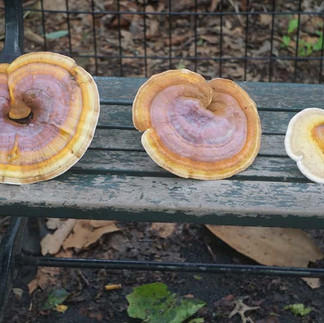Golden Reishi - Ganoderma curtisii
- Aubrey
- Aug 9, 2021
- 3 min read
Good evening friends,
This week's mushroom is Ganoderma curtisii, commonly known as Golden Reishi. The featured mushrooms were first found in the ramble on 6/16/2021 (picture 1) and was revisited to find mature mushrooms on 7/11/2021 (pictures 2 and 3). G. curtisii was originally thought to be a southern species but DNA testing revealed it is commonly found east of the Rockies and not just in the south. Like G. applanatum of last week, it is saprobic and get its nutrients from dead wood (in this instance it is growing out of dead roots underground). Unlike G. applanatum, it is physically different because of the lacquered texture and conspicuous coloring on the cap and stipe. However, there are other Ganoderma species that are quite similar in appearance - like G. sessile. A couple physical differences to distinguish between the two is that G. curtisii tends to have a pronounced "neck" or stipe and has blue coloration on the cap/stipe . Unfortunately, some of these physical characteristics are rather variable so substrate, location, and microscopic differences are important as well.
As I did further research, I discovered how convoluted it is to decipher factual information regarding each individual species in the genus Ganoderma. The taxonomical order of Ganoderma species in the country still needs to be sorted out and, with that organization, hopefully the physical differences will become more succinct. Several species in the genus have recently been taxonomically divided/reclassified into separate species which makes a lot of research inapplicable since we're unsure which species was actually tested. G. curtisii was initially known as Ganoderma lucidum, and still can be considered part of the "Ganoderma lucidum complex" even though G. lucidum is native to Europe. This is one reason why all the health claims are unsubstantiated. All the research I site has been published within the last three years because I want it to be as current, and precise to the species, as possible. Nonetheless, I was still able to confirm that Ganoderma curtisii possesses antimicrobial, anti-inflammatory, and neuroprotective chemicals.(1,2)
One application of all the purported medicinal compounds of these Ganoderma species is to turn fruiting bodies into tinctures, extracts, and powders. These supplements are used as a natural way to help with blood pressure, immune response, inflammatory response, sleep quality, respiratory health, nerve support, and liver health.(3) Personally, I add a teaspoon or two of a liquid Reishi extract into my coffee every other morning. I'm even going through the steps to produce my own extract with mushrooms that I have harvested myself. If you're interested in this process reach out to me and I can explain more. And of course, as with any personal health decision, you want to do your own research and perhaps even consult a medical professional before introducing a new health supplement into your body.
One last interesting note was that out of 20 commercial Reishi products available (teas, powders, supplements), 16 were composed of multiple species of Ganoderma - and the vast majority contained the Asian species G. Lingzhi. For what it's worth, G. Lingzhi is the original Reishi and has the most scientifically verifiable health benefits, so the consumer is getting the most verifiable health benefits. I'd suggest if you were to pursue a Reishi supplement you should look for a local source (maybe at a farmers' market) where you can ask questions and be certain of the mushrooms used in production.
This was probably one of the longer and more convoluted MMs we've had, so I thank you for bearing with me. The one thing we really know is that the genus is overlooked and underappreciated - but you could say that about the kingdom of fungi as a whole.
Hydrate this week,
Aubrey
In-text References:
1) Leon-Rivera I, Villeda-Hernandez J, Montiel-Arcos E, Tello I, Rios MY, Estrada-Soto S, et al. Neuroprotective Effects of Ganoderma curtisii Polysaccharides After Kainic Acid-Seizure Induced. Pharmacognosy Journal. 2019;11(5):1046-1054.
2) Islas Rodríguez, Alfonso Enrique & Barragán-Reynaga, Dolores & Moya, Carlos & Reynoso Silva, Monica & Dávalos, Laura & Villalobos-Arámbula, Alma. (2020). ANTIMICROBIAL ACTIVITY PRESENT IN Ganoderma curtisii AQUEOUS EXTRACTS. e-CUCBA. 8-24. 10.32870/e-cucba.v0i14.158.
4) Loyd AL, Richter BS, Jusino MA, Truong C, Smith ME, Blanchette RA and Smith JA (2018) Identifying the “Mushroom of Immortality”: Assessing the Ganoderma Species Composition in Commercial Reishi Products. Front. Microbiol. 9:1557. doi: 10.3389/fmicb.2018.01557
Additional References:
5) Kuo, M. (2019, January). Ganoderma curtisii. Retrieved from the MushroomExpert.Com Web site: http://www.mushroomexpert.com/ganoderma_curtisii.html






